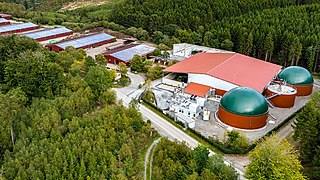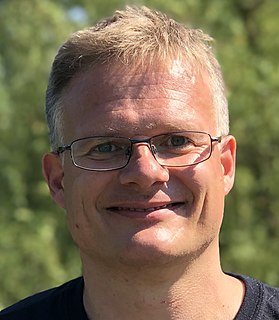Related Research Articles

Compost is a mixture of ingredients used to fertilize and improve the soil. It is commonly prepared by decomposing plant and food waste and recycling organic materials. The resulting mixture is rich in plant nutrients and beneficial organisms, such as worms and fungal mycelium. Compost improves soil fertility in gardens, landscaping, horticulture, urban agriculture, and organic farming. The benefits of compost include providing nutrients to crops as fertilizer, acting as a soil conditioner, increasing the humus or humic acid contents of the soil, and introducing beneficial colonies of microbes that help to suppress pathogens in the soil. It also reduces expenses on commercial chemical fertilizers for recreational gardeners and commercial farmers alike. Compost can also be used for land and stream reclamation, wetland construction, and landfill cover.
Thermal depolymerization (TDP) is the process of converting a polymer into a monomer or a mixture of monomers, by predominately thermal means. It may be catalysed or un-catalysed and is distinct from other forms of depolymerisation which may rely on the use of chemicals or biological action. This process is associated with an increase in entropy.

Water treatment is any process that improves the quality of water to make it appropriate for a specific end-use. The end use may be drinking, industrial water supply, irrigation, river flow maintenance, water recreation or many other uses, including being safely returned to the environment. Water treatment removes contaminants and undesirable components, or reduces their concentration so that the water becomes fit for its desired end-use. This treatment is crucial to human health and allows humans to benefit from both drinking and irrigation use.

Bioremediation is a process used to treat contaminated media, including water, soil and subsurface material, by altering environmental conditions to stimulate growth of microorganisms and degrade the target pollutants. Cases where bioremediation is commonly seen is oil spills, soils contaminated with acidic mining drainage, underground pipe leaks, and crime scene cleanups. These toxic compounds are metabolized by enzymes present in microorganisms. Most bioremediation processes involve oxidation-reduction reactions where either an electron acceptor is added to stimulate oxidation of a reduced pollutant or an electron donor is added to reduce oxidized pollutants. Bioremediation is used to reduce the impact of byproducts created from anthropogenic activities, such as industrialization and agricultural processes. In many cases, bioremediation is less expensive and more sustainable than other remediation alternatives. Other remediation techniques include, thermal desorption, vitrification, air stripping, bioleaching, rhizofiltration, and soil washing. Biological treatment, bioremediation, is a similar approach used to treat wastes including wastewater, industrial waste and solid waste. The end goal of bioremediation is to remove or reduce harmful compounds to improve soil and water quality.
Biodiesel production is the process of producing the biofuel, biodiesel, through the chemical reactions of transesterification and esterification. This involves vegetable or animal fats and oils being reacted with short-chain alcohols. The alcohols used should be of low molecular weight. Ethanol is the most used because of its low cost, however, greater conversions into biodiesel can be reached using methanol. Although the transesterification reaction can be catalyzed by either acids or bases, the base-catalyzed reaction is more common. This path has lower reaction times and catalyst cost than those acid catalysis. However, alkaline catalysis has the disadvantage of high sensitivity to both water and free fatty acids present in the oils.
Cellulosic ethanol is ethanol produced from cellulose rather than from the plant's seeds or fruit. It can be produced from grasses, wood, algae, or other plants. It is generally discussed for use as a biofuel. The carbon dioxide that plants absorb as they grow offsets some of the carbon dioxide emitted when ethanol made from them is burned, so cellulosic ethanol fuel has the potential to have a lower carbon footprint than fossil fuels.

Anaerobic digestion is a sequence of processes by which microorganisms break down biodegradable material in the absence of oxygen. The process is used for industrial or domestic purposes to manage waste or to produce fuels. Much of the fermentation used industrially to produce food and drink products, as well as home fermentation, uses anaerobic digestion.

ATCC or the American Type Culture Collection is a nonprofit organization which collects, stores, and distributes standard reference microorganisms, cell lines and other materials for research and development. Established in 1925 to serve as a national center for depositing and distributing microbiological specimens, ATCC has since grown to distribute in over 150 countries. It is now the largest general culture collection in the world.
Bioconversion, also known as biotransformation, is the conversion of organic materials, such as plant or animal waste, into usable products or energy sources by biological processes or agents, such as certain microorganisms. One example is the industrial production of cortisone, which one step is the bioconversion of progesterone to 11-alpha-Hydroxyprogesterone by Rhizopus nigricans. Another example is the bioconversion of glycerol to 1,3-propanediol, which is part of scientific research for many decades.

Waste-to-energy (WtE) or energy-from-waste (EfW) is the process of generating energy in the form of electricity and/or heat from the primary treatment of waste, or the processing of waste into a fuel source. WtE is a form of energy recovery. Most WtE processes generate electricity and/or heat directly through combustion, or produce a combustible fuel commodity, such as methane, methanol, ethanol or synthetic fuels.

Biodegradable plastics are plastics that can be decomposed by the action of living organisms, usually microbes, into water, carbon dioxide, and biomass. Biodegradable plastics are commonly produced with renewable raw materials, micro-organisms, petrochemicals, or combinations of all three.

Abengoa, S.A. is a Spanish multinational company in the green infrastructure, energy and water sectors. The company was founded in 1941 by Javier Benjumea Puigcerver and José Manuel Abaurre Fernández-Pasalagua, and is based in Seville, Spain. Its current chairman is Gonzalo Urquijo Fernández de Araoz. After repeated bankruptcies and rescues, it declared insolvency in February 2021 amid various regulatory and financial charges against the board and management, the second-largest corporate collapse in Spanish history.

Sewage treatment is a type of wastewater treatment which aims to remove contaminants from sewage to produce an effluent that is suitable for discharge to the surrounding environment or an intended reuse application, thereby preventing water pollution from raw sewage discharges. Sewage contains wastewater from households and businesses and possibly pre-treated industrial wastewater. There are a high number of sewage treatment processes to choose from. These can range from decentralized systems to large centralized systems involving a network of pipes and pump stations which convey the sewage to a treatment plant. For cities that have a combined sewer, the sewers will also carry urban runoff (stormwater) to the sewage treatment plant. Sewage treatment often involves two main stages, called primary and secondary treatment, while advanced treatment also incorporates a tertiary treatment stage with polishing processes and nutrient removal. Secondary treatment can reduce organic matter from sewage, using aerobic or anaerobic biological processes.
Many microorganisms can naturally grow together on surfaces to form complex aggregations called biofilms. Much research has been done on methods to remove biofilms in clinical and food manufacturing processes, but biofilms are also used for constructive purposes in a variety of industries. One distinctive characteristic of biofilm formation is that microorganisms within biofilms are often much tougher and more resistant to environmental stress compared to individual microorganisms. The cells are stationary and are able to adapt to adverse environments. This phenomenon of enhanced resistance can be beneficial in industrial chemical production where microorganisms within biofilms may tolerate higher chemical concentration and act as robust biorefineries for various products. These microbes have also been used in bioremediation to remove contaminants from freshwater and wastewater. More novel uses of biofilms include generating electricity using microbial fuel cells. Challenges to scaling up this technology include cost, controlling the growth of biofilms, and membrane fouling.

Agricultural Engineering is the field of study and application of engineering science and designs principles for agriculture purposes, combining the various disciplines of mechanical, civil, electrical, food science, environmental, software, and chemical engineering to improve the efficiency of farms and agribusiness enterprises as well as to ensure sustainability of natural and renewable resources.
The Faculty of Agriculture of Kagawa University specialises in pure and applied research in bioscience and biotechnology.
Bioproducts or bio-based products are materials, chemicals and energy derived from renewable biological resources.
Algae fuel in the United States, as with other countries, is under study as a source of biofuel.
Single cell oil, also known as Microbial oil consists of the intracellular storage lipids, triacyglycerols. It is similar to vegetable oil, another biologically produced oil. They are produced by oleaginous microorganisms, which is the term for those bacteria, molds, algae and yeast, which can accumulate 20% to 80% lipids of their biomass. The accumulation of lipids take place by the end of logarithmic phase and continues during station phase until carbon source begins to reduce with nutrition limitation.

Miklas Scholz is a Professor in Water Resources Engineering at Lund University. He holds the Chair in Civil Engineering at University of Salford where he serves as a Professor and the Head of the Civil Engineering Research Group. Scholz is also a Distinguished Professor at Johannesburg University and the Central University of Technology.
References
- ↑ Smithers, JC (October 14, 2009). "WHAT IS BIORESOURCES ENGINEERING?" Prospective Students". School of Bioresources Engineering & Environmental Hydrology. Archived from the original on September 21, 2008.
- ↑ Goldberg, Lee. "Bioresources Engineering Archived August 19, 2009, at the Wayback Machine ." Welcome to the Department of Bioresources Engineering. College of Agriculture, n.d. Web. 13 Oct. 2009.
- ↑ Verma, Preeti, and Rashmi Sanghi. "Bioresource Technology." Research GATE.N.p., Aug. 2008. Web. 13 Oct. 2009.
- ↑ Verma, Preeti, and Rashmi Sanghi. "Bioresource Technology." Research GATE. N.p., Aug. 2008. Web. 13 Oct. 2009.
- ↑ "ATCC: Who We Are". Archived from the original on September 25, 2009. Retrieved October 15, 2009.
